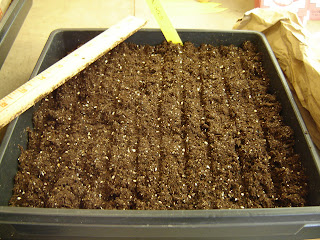On Saturday, April 9th I headed off to the Bellevue Demo Garden (BDG) for my 2nd year internship's first clinic. Daffies were busting out all over...... spring is definitely springing at the BDG!
As you know from an
earlier post I requested a transfer to the Bellevue Demonstration Garden for my clinic rotations. Right off the bat I noticed the difference....... so much more my thing! I was able to get up and walk around. When things were slow I hung out in the garden with the other Master Gardeners and got to watch them in action/ask questions, and when it got even quieter (from a clinic perspective) I was invited to go and sit in on the Saturday workshop up at the Ranger Station. They were discussing how to design/build cold frames - got to see recycling in action big time.... amazing what you can use to build a cold frame with..... old windows and sliding glass doors, decking, electrical conduit, PVC piping, used rebar, basement window well covers.... the list goes on!
Back at the clinic, we had a visitor with an interesting question..... "where can I buy burlap socks and organic straw - I want to make a raised bed?" Here's an example of what she's trying to do...... obviously this photo shows it being done on a big scale, but you get the idea....
Well I've heard of burlap
SACKS, but not burlap SOCKS. I suggested she save her $$$ and get her sacks for free (told her about my recent
Starbucks adventure), then cut them in half and sew up the side and voila... SOCKS galore! Organic straw? Mmmmmm, I'm thinking organic farms would have plenty of the stuff.
Luckily it didn't rain, even though it looked like the skies would open up and dump on us at any minute. Got to spend some of the quiet time reading bits of this book from the clinic library cart.........

.....suffice to say..... I think it's a real winner! The price on the back showed $18.95, and based on the small amount of the book I got to read on Saturday I could already tell it was good money well spent! Even though the title appears to be very focused on vegetable gardening, the contents looked applicable to a more broad audience. Soil preparation/recipes for making your own to save $$$, seeding tips the average gardener doesn't know, how to be a smart buyer when purchasing potted starts/plants (how the nurseries make a potted plant look good for sale, when in fact it might not be a healthy choice).... all kinds of good stuff. Detailed explanations that tell me the whys of things, and not just what to go and do...... I like that in a book. I highly recommend you go find a copy and check it out for yourself.

On one particular walkabout I learned how to speed up the composting process and get quicker benefit from the results. As you know, compost piles need good doses of air to do their thing. So, when you rotate the pile, why not sift some of it out and take the bits that are ready for your garden, and put the remainder back to keep breaking down? Sifting adds plenty of air (ask any baker!) so you're really doing your compost pile a good service. I've always sat and waited for the entire pile to get good and ready, not realizing it's already there for the taking if I need it. The sieve you see here is just a simple wooden frame with some fine wire mesh tacked on the bottom.... worked like a charm.

So, it looks like I made the right decision to switch clinics. If you're an up-and-about type person like me who doesn't sit well, the BDG clinic will give you what you need, and make your clinic rotations a much more enjoyable experience. Now I'm looking forward to the next one rather than dreading it. :)















